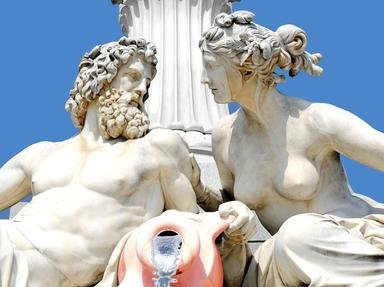Quiz Answer Key and Fun Facts
1. Who was the queen of the Sumerian netherworld?
2. Death was of extreme mystic significance in ancient Egyptian religious belief. Indeed, few if any of the Egyptian gods and goddesses are not associated in some way with the Egyptian afterlife. However, at least two Egyptian deities enjoy special mortuary prominence. First: who was the "Opener of the Ways" who guided the souls of the newly-deceased through the early stages of the Egyptian afterlife?
3. Second: which Egyptian deity had dominion over the dead and over the Western Lands where souls traveled after death?
4. Which of the following is the Japanese god (Shinto and Buddhist) of the underworld?
5. Which of the following was the greatest and most powerful of the ten Lords of Death in classical Chinese mythology?
6. In Hindu practice, Lord Shiva is the Destroyer; he and his consort Kali both partake to a high degree of the mysteries and energies of death. However, one Hindu god is particularly known as the "God of Death" -- which of the following gods bears that distinction?
7. The ancient Greeks had a particularly highly-developed system of beliefs in connection with the personification of every aspect of the death experience. For that reason -- and because covering Greek mythology also covers ancient Roman and Etruscan theogony as well -- it is worth dedicating five questions to death in Greek mythology. First: what Greek deity was responsible for taking each person's life when it was time for that person to die?
8. Second: what Greek deity was responsible for guiding the souls of the dead to the underworld, once they had died?
9. Third: in Greek mythology, what was the name of the boatman who ferried the souls of the dead across the river Styx?
10. Fourth: which of the following was NOT one of the three beings who judged the souls of the dead in Greek mythology?
11. Fifth: Which of the following is NOT a Greek name for the god of the dead, the ruler of the Greek underworld and afterlife?
12. In Mayan cosmology, which of the following was the god of the dead and ruler of the lowest of the underworlds?
13. In Aztec cosmology, which of the following was the god of the dead and ruler of the lowest of the underworlds?
14. What daughter of Loki was the Norse goddess of death?
15. Who most clearly personified violent death for the pre-Christian Irish?
16. In the Talmud (Abodah Zarah 20), what name is given to the Angel of Death, described as "altogether full of eyes"?
17. Which of the following is a name (arguably the most commonly-cited name) given to the Angel of Death in Hebrew, Christian and Islamic tradition?
18. In the Islamic tradition reflected in the Thousand Nights and a Night, which of the following is the name of the Angel of Death?
19. According, at least, to John of Patmos, Death incarnate rides a horse of what color?
20. In Vodou belief, which of the following is best described as the Loa of the Dead?
21. I have reserved the last five questions for the iconography of death in the visual arts. In the 1490 painting by Hieronymus Bosch, "Death and the Miser," Death is represented holding what object in his hand?
22. In the painting "The Triumph of Death" by Pieter Bruegel the Elder (circa 1562), Death is represented holding what object in his (its) skeletal hand?
23. In the visual arts, the phrase "La Danse Macabre" refers to what artistic theme or motif?
24. In the visual arts, the phrase "Death and the Maiden" refers to what artistic theme or motif?
25. Which of the following films revolves around a chess game between Death personified and a living mortal?
Source: Author
xaosdog
This quiz was reviewed by FunTrivia editor
thejazzkickazz before going online.
Any errors found in FunTrivia content are routinely corrected through our feedback system.

